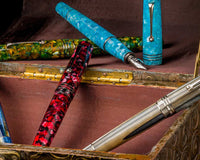The variety of ink available for fountain pens amplifies creativity. Writing takes on colorful flair, and the type of ink you choose can affect the thickness and flow of your lines. These tips for finding the best fountain pen ink will help you choose inks that best suit your style.
Your choice of inks will be defined by your pen—whether it uses cartridges exclusively or is convertible for use with bottled ink. Some pens don’t use cartridges at all. Instead, you fill them from a bottle using an eyedropper or a built-in piston or vacuum filling system. Bottled inks offer a much wider variety of color. The bottles are more expensive than cartridges, but last longer, so you may find bottled ink to be a better value. Many ink bottles are beautifully shaped and styled, and add elegance to your writing desk. However, if convenience and speed are what you’re looking for, standard international cartridges provide a good basic selection of inks.
Wetness
Though it seems odd to describe liquid ink as “wet” or “dry”, what this refers to in terms of fountain pen ink is how it flows through the pen. A “wetter” ink flows though the pen more quickly than a “dry” ink.
Wetter inks feel smooth for writing, but are also more prone to bleeding through paper, or feathering. Some pens are also rated as wetter or dryer, so your ink should match your pen.
Pigment or Dye Based Inks
Inks made with pigments contain tiny, water soluble colorants. This means they aren’t waterproof, but they clean up easily with water. Pigment based inks use particles that embed themselves in paper and become waterproof when they dry. Using pigment-based ink requires you to clean your pen frequently, and never allow the ink to dry in the reservoir. Dye-based inks offer a wider range of color, while pigment inks offer greater permanence.
Another type of ink is called iron gall ink. This type has been used since the middle ages. Although they are highly waterproof, and they darken as they dry, older versions were very corrosive. Newer formulas are gentler, but dyes used in them aren’t waterproof. If you spill water on your writing, only the oxidized iron in the ink remains—the color washes out, leaving only a dark grey.
Special Attributes
The growing popularity of fountain pens has seen a corresponding growth in the varieties of inks available. You can find ink that shimmers with glitter, invisible ink that appears only under UV light, and ink that appears metallic (has a “sheen”) in the loops and pools of your writing, when held at various angles. Shade inks look lighter or darker at different points of your writing. Some ink provides more saturated color than others, which can appear more transparent. You can even get scented ink.
One final tip for choosing fountain pen ink: the quality of paper you choose will affect how the ink you select behaves. Higher quality paper resists feathering or bleed-through. If you will be writing on lower quality or generic paper, choose an unfussy ink known to resist smearing, feathering and bleed-through.
At Endless Pens, we have an impressive variety of fountain pens for sale. Please contact us if you have any questions!
By Some Folks at EndlessPens







